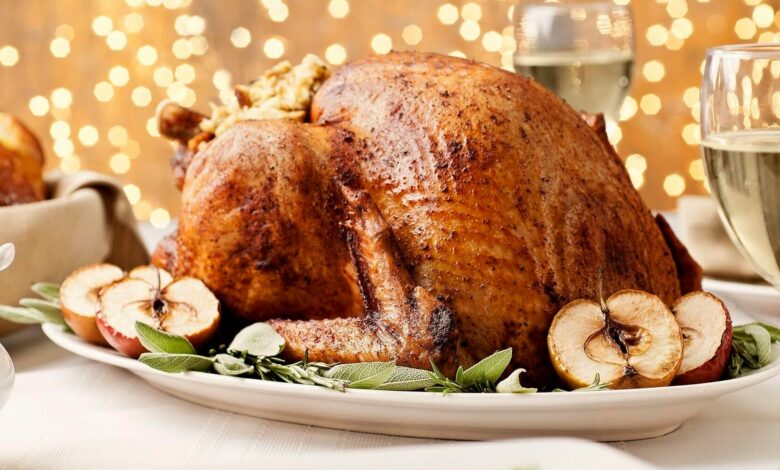Essential tips for nailing your Thanksgiving turkey this year

Thanksgiving is just around the corner, which means it’s time. If you’re hosting, you should start planning your menu now, preparing your home for guests and brushing up on your cooking techniques. But it’s also time to think about the main event: the turkey.
How will you prepare the turkey? Are you going to make it in an oven? Do you have all the materials you need? The last thing you want is to procrastinate. Thanksgiving is not called Turkey Day for nothing. It’s important that you follow your turkey recipe closely – and we can help. Here’s everything you need to know to slay your Thanksgiving turkey this year.
For more holiday hacks, check out our Thanksgiving cheat sheet to capture the day.
How Much Turkey Do You Need This Thanksgiving?
If you want to go all out and make a whole turkey, you certainly can. If you want to save time and money by going for a turkey breast instead, you can do that too. Although it can be difficult to determine how much turkey each guest will eat, a good rule of thumb is to purchase one to one and a half pounds of turkey per person. That means a standard 12- to 15-pound turkey should feed about eight people as part of a meal, and you can scale up or down as needed.
A beautifully prepared turkey is in your future.
What is the best way to thaw a turkey?
Don’t forget this step – definitely don’t forget this step. Unless you buy a pre-cooked turkey at the grocery store, your turkey is most likely purchased frozen. This means you’ll need to plan ahead, as it will take one to six days to completely thaw your turkey.
You can follow our complete guide on how to thaw turkey with the best methods, but it’s actually quite simple: all you need is time.
The best method is to thaw the turkey in the refrigerator. The USDA recommends 24 hours for every 4 to 5 pounds in a refrigerator set at 40 degrees Fahrenheit or lower, so you’ll need several days to fully thaw your bird. Additionally, once the turkey is completely thawed, you can store it in the refrigerator for up to two days. So feel free to start a day earlier and plan another day of rest before you actually start cooking.
How long does it take to cook a turkey?
The cooking time of course depends on how much turkey you prepare. The most important thing is that your turkey is cooked to the correct temperature (165-170 F), so you will have to rely on a meat thermometer for help. (Don’t trust the pop-up turkey timer that may be in your bird – it usually won’t pop until the turkey is overcooked.)
That said, here are some general guidelines based on an oven temperature of 350 degrees F, our preferred temperature for roasting turkey.
How long to cook a turkey
| 12-14 pounds | ~3 hours |
|---|---|
| 15-18 pounds | ~3.5 to 4 hours |
| 18-20 pounds | ~4 to 4.5 hours |
| 21-24 pounds | ~4.5 to 5 hours |
I recommend checking your bird occasionally to make sure it isn’t drying out (read on for tips on how to fix a dry turkey).
If you prefer a higher temperature method, it will obviously take less time, but you run the risk of burning the skin of the turkey; so does the “start high and then turn the heat down” method. It is more reliable (and easier) to keep the oven at the same temperature all the time.
Here is a guide to turkey roasting times.
Should you brine your turkey?
This is certainly optional, but I recommend brining a turkey the day before roasting it. Brining is the process of covering the meat with salt to tenderize and hydrate the meat. Turkey is a leaner meat and the light part cooks faster, meaning that by the time the dark meat is fully cooked, the light meat may be overcooked. Brining can help prevent dehydration.
There are two popular brining methods: dry brine and wet brine. Dry brining involves rubbing coarse salt over the turkey; Wet brining involves soaking the bird in a saltwater bath. For either method, the turkey must be completely thawed.
Brining can take eight to eighteen hours. A word of caution: brining for too long can have the opposite effect and dry out your turkey, so I recommend brining for a maximum of 24 hours. Additionally, most supermarket birds come pre-injected with a saline solution, so brining is probably not necessary.
Tools You Need to Cook a Turkey
A basic roast turkey recipe doesn’t require any special ingredients or chef-quality equipment — and you probably already have most of the things in your kitchen. But here’s an overview of what you’ll need:
- A frying pan with a rack.
- A turkey sandwich
- A meat thermometer.
Although you can use any meat thermometer, I recommend using this one The iQ Sense wireless thermometer from CHEF iQ.
How to season a turkey
You need to season your turkey, so you’ll need some of it fresh herbsspices and aromatics. Below we have a spice recipe that is a great starting point for any novice or professional, but you can always adjust it to your own taste as needed. You can always use store-bought poultry seasoning, but make sure you buy it fresh.
Here is a basic shopping list for turkey seasoning:
- Kosher salt
- Freshly cracked black pepper
- Vegetable oil (or olive oil)
- Half a stick of butter (softened at room temperature)
- Half a lemon
- Half an onion (cut into four pieces)
- One celery stalk (cut into three pieces)
- Fresh sage
- Fresh thyme leaves
- Bay leaves (fresh or dried)
What’s the Best Way to Roast a Thanksgiving Turkey?
Here’s our advice for roasting your bird on Thanksgiving (or whenever you celebrate):
1. Make sure the turkey is completely thawed the day before you plan to roast it, then remove the contents from the oven cavity. Discard the giblets (heart, liver and gizzard), but save them for making a gravy or stuffing. Reserve the neck!
2. Rub the turkey liberally with salt, including under the skin of the breast.
3. Place the turkey on a pan or baking sheet, cover with plastic wrap and refrigerate until the next day when you roast it. This keeps the bird tasty and juicy.
4. The next day, place the oven rack in the bottom third of the oven and preheat to 350 degrees F. This will take about 20 minutes, so in the meantime, remove the turkey from the refrigerator and prepare it for roasting according to the following steps.
5. Pat the turkey completely dry (inside and out) with paper towels and tuck the wing tips back and under the body. Rub a generous amount of vegetable oil into the cavity, on the outside and under the skin. Then season well with salt and pepper, also in the abdominal cavity.
6. Mix the fresh herbs (listed in the section above) into the softened butter, break them into small pieces and place them under the skin covering the breast. Place the lemon, onion, bay leaf and celery in the abdominal cavity. (Although many still stuff stuffing into the cavity, this method has been linked to salmonella outbreaks because the turkey may not come up to temperature. Cooking it separately will result in a crispier surface and juicier meat.)
7. Place the turkey breast side down on the roasting rack and place the reserved neck in the bottom of the pan for extra flavor. Roast the turkey in the oven for 45 minutes, basting the turkey every 20 minutes as the juices begin to pool in the pan.
8. After 45 minutes, turn the turkey on its back and baste it every 20 minutes. Roast for about two to two and a half hours (follow the cooking time chart above).
9. When a meat thermometer inserted in the inner thigh registers 170 degrees F and the juices run clear, remove the turkey from the oven. Let it rest for 20 to 30 minutes before slicing. If you plan to make your own turkey gravy, set the roasting pan aside and reserve the vegetables from the cavity of the bird as well as from the neck.
Look for these temperatures in your turkey: 180F in the thigh, 170F in the breast, 165F in the stuffing.
Or try this easier method
Flipping the turkey can be a chore, but this method is easier and still just as delicious. You can easily roast the turkey standing upright for the entire cooking time.
I recommend that you baste the brisket every 30 to 40 minutes to ensure it is tender and not drying out. You can also cover the pan with aluminum foil if the skin starts to brown before the meat is done. Remove the foil during the last few minutes to get a nice crispy skin on the turkey.
How do you prepare a speckled turkey?
If you want to improve some cooking skills, you can spatchcock the turkey before roasting it. Spatchcocking a turkey simply means removing the backbone so that it lies flat while roasting. This technique ensures that the turkey cooks faster and more evenly, resulting in juicy white meat and crispy skin.
If you go this route, you don’t have to start the turkey breast side down, but you will need to check the meat earlier than normal because it will cook faster.
How to fix overcooked, dry turkey
Despite your best efforts (and the help of this guide), sometimes things can go wrong. The good news is that you can usually fix your cooking mistakes.
To moisten dry turkey, dilute equal parts gravy with well-seasoned stock and pour the mixture over the meat. You can then cover the meat with foil and place it in the oven at 400 degrees F for 10 to 15 minutes. Plus, you can always braise the meat with gravy or cranberry sauce.
How to fix undercooked raw turkey
If your deceptively golden brown turkey turns out to be raw on the inside, there are some ways to fix the undercooked meat. Don’t just throw it back in the oven. Follow this guide:
First, cut off the legs and breasts from the turkey (try to keep them as intact as possible). Then place the pieces on a baking sheet and place them in a preheated oven at approximately 375 degrees F. Check the meat with a meat thermometer about every 15 minutes until the pieces reach an internal temperature of 165 degrees F. Then cut the turkey into pieces and serve on a platter.




